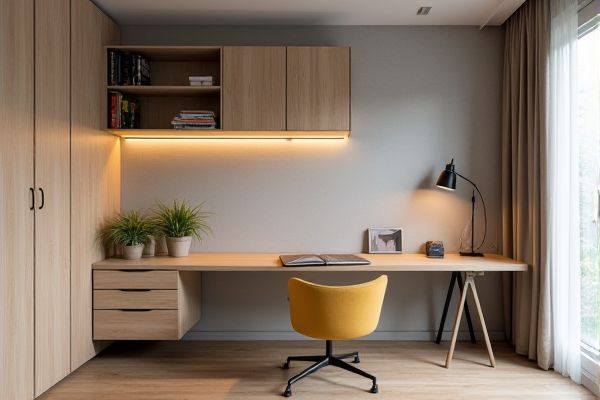
Under-desk cabinets maximize workspace efficiency by providing easy access to storage without occupying wall space, ideal for small or compact rooms. Explore the rest of the article to determine which cabinet type best suits your organizational needs and workspace layout.
Table of Comparison
| Feature | Under-Desk Cabinet | Wall Cabinet |
|---|---|---|
| Installation | Mounted under desk surface, easy to access | Mounted on wall, requires drilling and sturdy support |
| Space Usage | Utilizes floor or desk underside space, saves floor space | Utilizes vertical wall space, frees up floor and desk area |
| Storage Capacity | Typically smaller, ideal for files and small items | Usually larger, suitable for books, binders, and bulky items |
| Accessibility | Easily reachable while seated | May require standing or stretching |
| Security | Often includes lock options for confidential storage | Lock options available, but less common |
| Design/Appearance | Blends with desk, minimal visual impact | Visible on wall, can enhance room decor |
| Cost | Generally lower cost | Often higher cost due to installation and size |
Introduction to Cabinet Placement Options
Under-desk cabinets maximize workspace efficiency by providing storage directly beneath your desk, keeping essential items within easy reach while maintaining a clean surface. Wall cabinets utilize vertical space to free up floor area, ideal for storing less frequently used materials and adding visual organization to your room. Choosing between under-desk and wall cabinets depends on your storage needs, available space, and desired accessibility.
Overview of Under-Desk Cabinets
Under-desk cabinets offer compact storage solutions designed to maximize workspace efficiency by fitting directly beneath desks, providing easy access to files and office supplies. These cabinets often feature lockable drawers and ergonomic designs that support organization without occupying additional floor space. Ideal for small offices or home workstations, under-desk cabinets enhance workspace functionality while maintaining a clutter-free environment.
Overview of Wall Cabinets
Wall cabinets maximize vertical space by mounting securely to the wall, offering accessible storage without occupying floor area. Ideal for offices or kitchens, they keep your workspace organized while freeing up room below for movement or other furniture. Their sturdy construction supports frequent use and easy customization with adjustable shelves to fit various storage needs.
Space Utilization and Efficiency
Under-desk cabinets maximize space utilization by fitting seamlessly beneath work surfaces, offering easy access to essential items while keeping your workspace uncluttered. Wall cabinets save valuable floor area by utilizing vertical space, making them ideal for small rooms or offices needing efficient storage solutions. Choosing between the two depends on your specific space constraints and how you prioritize accessibility versus maximizing floor space.
Accessibility and Ergonomics
Under-desk cabinets offer enhanced accessibility by keeping essential items within arm's reach, promoting ergonomic efficiency during work hours. Wall cabinets, while providing ample storage, may require standing or stretching, potentially causing strain and disrupting workflow. Your choice between under-desk and wall cabinets should prioritize ease of access and comfort to maintain productivity and reduce physical fatigue.
Storage Capacity Comparison
Under-desk cabinets offer greater storage capacity due to their larger dimensions and multiple drawers, making them ideal for bulky office supplies and files. Wall cabinets provide limited storage space but maximize vertical area, suitable for lightweight items and documents. Choosing between the two depends on the need for accessible, spacious storage versus optimizing floor space with overhead compartments.
Aesthetic and Design Considerations
Under-desk cabinets offer a sleek, space-saving design that maintains a clean, unobtrusive look while providing easy access to storage directly beneath your workspace. Wall cabinets contribute to an open, airy aesthetic by freeing up floor area and allowing for decorative displays or additional lighting options, enhancing the room's overall design. Your choice between these storage solutions should align with your room layout and personal preference for either streamlined functionality or enhanced visual appeal.
Installation and Maintenance Differences
Under-desk cabinets require floor-level installation, often involving bolts for stability and easy access for maintenance, while wall cabinets demand secure wall mounting with studs for weight support and periodic checks for wall integrity. Maintenance of under-desk units typically involves cleaning dust and lubricating drawer tracks, whereas wall cabinets need inspections for wall anchors and hardware tightness to ensure safety. Installation of wall cabinets is generally more complex and time-consuming due to height and alignment considerations compared to the relatively straightforward placement of under-desk cabinets.
Cost Analysis: Under-Desk vs. Wall Cabinets
Under-desk cabinets typically cost less upfront due to smaller size and simpler installation compared to wall cabinets, which require mounting hardware and potential wall reinforcement. Wall cabinets may involve higher labor costs but offer increased storage that can reduce clutter and improve workspace efficiency in the long term. Evaluating your budget against space needs will help determine whether under-desk or wall cabinets offer the best value for your office setup.
Choosing the Right Cabinet for Your Workspace
Under-desk cabinets maximize workspace efficiency by providing accessible storage without occupying wall space, ideal for smaller offices or personal workstations. Wall cabinets offer increased vertical storage, freeing floor space and helping maintain a clutter-free environment, perfect for larger areas or shared workspaces. Consider workspace size, storage needs, and ergonomic convenience to select the cabinet that enhances productivity and organization effectively.
 homyna.com
homyna.com